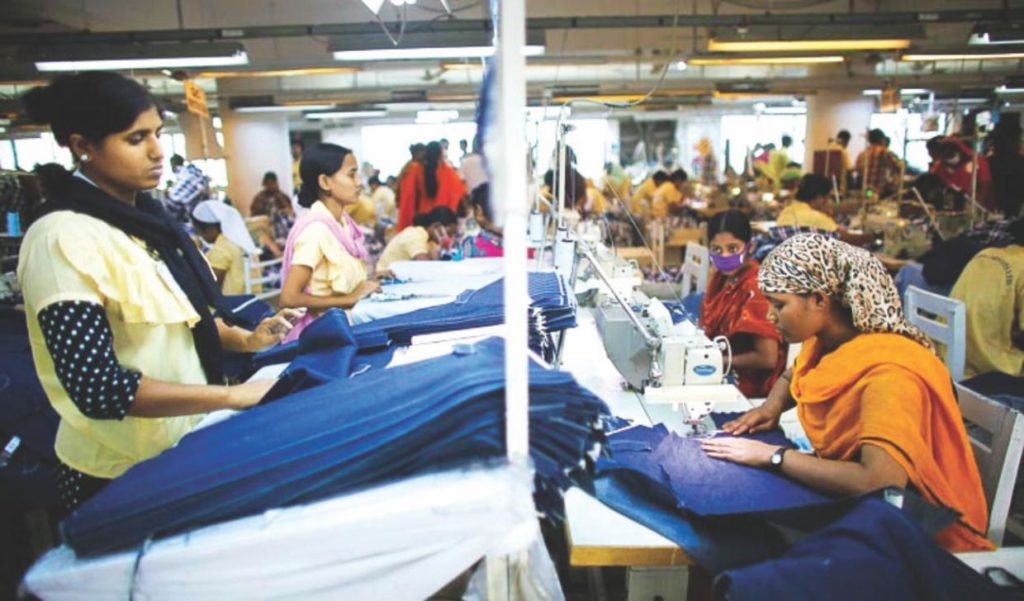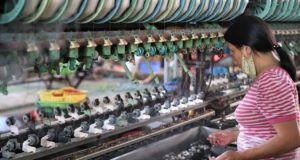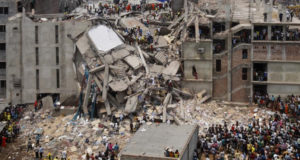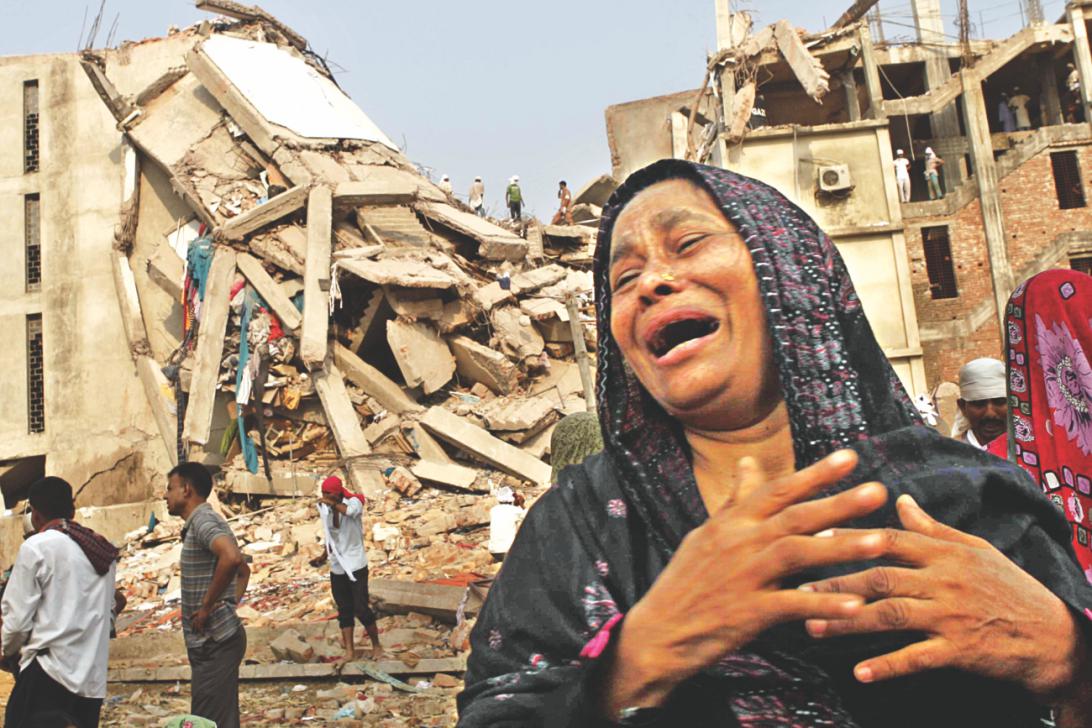By Garrett Brown
Published in The Daily Star on June 22, 2018

Photo: Reuters
In the five years following the collapse of Rana Plaza, Bangladesh has made real and unprecedented progress in improving workers’ health and safety in its garment industry. Now, the “sweatshop business model” of global capitalism is undermining those gains as international clothing brands cut prices paid to supplier factories in Bangladesh, and continue to roam the world looking for the lowest production costs, the most vulnerable workforce, and the weakest, most compliant governments.
The impact of what’s called “savage capitalism” by many in the developing world undercuts workers’ safety not only in garment plants in Bangladesh, but also in other global supply chain factories (electronics, toys, food, consumer goods) in every corner of the world. The downward pressure on working conditions and workers’ rights affects all the world’s workplaces, which are all in desperate competition with one another to produce the highest profits for transnational corporations.
Progress registered
The progress in Bangladesh’s apparel industry has been led by the Accord on Fire and Building Safety, a legally-binding agreement between more than 215 international clothing brands and two international unions and their Bangladesh affiliates. When the Accord began its work in 2013 among its factory base of 1,600 garment plants, 97 percent did not have safe exits out of the building, 91 percent did not have a fire detection and alarm system, and 70 percent had no load management plan to distribute weight in the building to prevent collapses.
By April 2018, the Accord’s 100+ engineers have conducted more than 25,500 initial and follow-up inspections and more than 99,000 specific electrical, fire safety and building structure hazards have been corrected—more than 60 per factory. Overall, 84 percent of the 123,000+ identified hazards have been eliminated, and 767 factories have completed more than 90 percent of their corrective action plans.
In the fall of 2017, the Permanent Court of Arbitration in The Hague ruled that two international clothing brands which signed the Accord were required to pay over 2 million USD to correct hazardous conditions in more than 200 supplier factories. The two unnamed brands had continued to source from suppliers that refused to correct Accord-identified hazards, prompting the arbitration claim by the international union signatories of the Accord under the binding agreement’s mandatory hazard correction provisions.
The other private-sector initiative—the Alliance for Bangladesh Worker Safety, whose safety standards mirror those of the Accord—reports that 322 of its 600 factories have completed 100 percent of their corrective action plans. Overall, 88 percent of identified hazards in all Alliance factories have been eliminated.
This set of workplace hazard identifications and hazard corrections, along with worker training on health and safety, is unprecedented for the worldwide garment industry. The Accord has set the bar for global supply chains for using state-of-the-art building and fire standards, competent and independent inspections, public reporting of all results, mandatory correction of all identified hazards, genuine worker participation in factory-level health and safety programmes.
This level of worker protection has never occurred before—not in garment supply chains and not in Bangladesh—and it is unmatched in any industry’s global supply chain and any other country supplying consumer goods for the developed world. These advances have come about due to the world-wide outrage after the Rana Plaza disaster, and in the aftermath of garment worker protests and mobilisations in Bangladesh over many years.
Progress unrealised
But even after industrial homicide on the scale of Rana Plaza, it has been impossible to get international clothing brands to meet all their responsibilities under national laws and international agreements.
Five years after the disaster, only 939 of the Accord’s 1,620 garment factories have corrected 75 percent or more of the identified safety hazards, with 1,290 factories “behind schedule” in completing their corrective action plans;
More than 270 garment factories—164 in the Alliance and 109 in the Accord—have been “terminated” by the initiatives for refusal to correct identified safety hazards. Many of these factories—now banned to supply Accord or Alliance brands—continue to produce garments under hazardous conditions for the domestic market or other international brands.
The principal reason why progress has been slow and incomplete in Bangladesh is that the international clothing brands and retailers have failed to provide their suppliers with the financial support needed to initiate and complete hazard corrections. Despite an Accord requirement for brands to ensure financing of mandatory hazard corrections, by April 2018, according to Accord, there were only 70 cases of confirmed brand-facilitated financing and 1,476 finance plans were “to be confirmed.”
The companies sourcing from Bangladesh include major international brands such as H&M, Gap, Abercrombie & Fitch, Tommy Hilfiger, Calvin Klein, and Jan Sport—as well major retail stores like Walmart, Kohl’s, Macy’s, Target and Sears. The profits these companies extract from their supply chains are more than 10 times the average return on sales of 2-4 percent for retail businesses. The trade journal Women’s Wear Daily reported that the top 25 leading brands had gross profits on sales revenue in 2015 of 40 percent and more.
Brand sourcing practices that would foster safer garment factories—in Bangladesh and in all global supply chains—would include higher per-unit prices, long-term contracts and stable sourcing, and providing grants or facilitating low-cost loans required for correcting major building and fire hazards. Owners of the supply factories already live on small profit margins and have few resources and little incentive to borrow money when future orders and reasonable prices are not guaranteed by the brands.
In addition, many international brands got a bad case of “buyer’s remorse” after signing onto the Accord or the Alliance immediately after Rana Plaza. Many international brands have done as little as they can get away with in addressing health and safety hazards in their supplier factories.
Progress undermined
At the same time that improvements in workplace safety has been achieved in Bangladesh, the workings of global supply chains have been eating away at this progress.
Bangladesh has become a case study of how global supply chains’ “iron triangle of sourcing”—the lowest possible price, highest possible quality, and fastest possible deliverable—redirects the resources needed to protect workers.
A major study of the Bangladesh garment industry by Pennsylvania State University in March 2018 found that:
The per-unit prices paid by international brands to supplier factories declined by 13 percent since the time of the Rana Plaza collapse in 2013;
Garment factory profit margins in Bangladesh decreased by 13.3 percent between 2011 and 2016; and
Lead times for delivery of brand orders also decreased by 8 percent in the period 2011-15.
One telling statistic related to Bangladesh’s 2016-17 exports is that the volume of exports (number of garments) actually increased by 10 percent over the last fiscal year, but the value of the products exported remained flat as the brands had collectively cut their prices to the suppliers by that same amount.
Brand sourcing practices that create lower prices, reduced profit margins and shorter lead times for delivery inevitably and predictably lead to violation of labour laws on wages and hours, particularly at the same time as local factories are being required to correct tens of thousands of fire, electrical and building safety hazards. The Pennsylvania researchers also found that real wages for garment workers in Bangladesh have declined 6.4 percent since December 2013.
As a representative of the Bangladesh Garment Manufacturers and Exporters Association (BGMEA) told researchers from the Middlesex University Business School in London in the fall of 2017: “But factories cannot produce cheaper without cutting corners on workers’ rights.”

Savage capitalism roams the world
In the last full fiscal year (July 2016 to June 2017), Bangladesh’s garment exports rose only 0.2 percent—basically even and well below the average 13 percent growth that occurred between 2006 and 2016. The total exports rose to just over 28 billion USD and Bangladesh is still the world’s #2 garment exporter behind China.
Exports rebounded in the July-November 2017 period, rising 6.7 percent over the same period in 2016, but the goal of USD 50 billion in apparel exports a year by 2021 promoted by the industry and government seems unlikely given recent trends in the global apparel market.
For example, China’s garment exports declined in 2017 by 14 percent or 8 billion USD from the year before. Bangladesh did not pick up this production, however, as the work has gone to Cambodia, Vietnam, and Myanmar. Chinese garment suppliers have been shifting orders from their factories in China to factories in southeast Asia. Wages in these countries are now “competitive” with Bangladesh and regulatory compliance costs are lower because there is no Accord or competent regulators with the political will to act.
At the same time, the Indian government spent 894 million USD in the last year to support the Indian garment sector. Between January and August 2017, India became the #2 supplier of garments to the United States market. Bangladesh dropped to sixth, as 60 percent of Bangladesh’s exports go to Europe. World wide, Bangladesh is the second highest exporter, with 6.4 percent of the global garment trade, but India is rising rapidly with 17 billion USD in exports (four percent of global trade) last year. Moreover, India is projected to increase its garment exports by 15 percent in 2017, to as much as 20 billion USD.
Meanwhile, East Africa continues to be the “new promised land”with major investments by apparel brands in garment factories.
In 2016, the 39 sub-Saharan countries generated 2.6 billion USD in clothing exports, with 92 percent of exports going to the United States under the duty-free provisions of the AGOA (Africa Growth and Opportunity Act). Africa offers wages even lower than Bangladesh and with near-zero regulatory compliance responsibilities. Chinese investors are flocking to the African continent, and the Beijing government has provided billions in loans for infrastructure development.
Ethiopia has become a rising player in global garment production, receiving 36.8 billion USD in foreign investment in 2016 and 2017. Since 2014, Ethiopia has opened four giant industrial parks with eight more slated to open by 2020, with a goal of creating two million manufacturing jobs by 2025. Ethiopia has provided international clothing brands with major tax breaks and incentives, low cost energy, improved transportation infrastructure, and little or no government corruption.
Ethiopia, the second most populous country in Africa with 105 million people, has a basic monthly wage of 25 USD compared to 66 USD in Bangladesh.
Ironically, at least 12 factories in East Africa are operated by Bangladesh garment suppliers for international brands. That is, the brands have contracted with Bangladesh suppliers to produce clothes, just not in Bangladesh but rather in Africa. Bangladesh manufacturers are investing in Africa to deal with Bangladesh’s anticipated loss of duty-free status as a “low income country” when the country is classified as a “middle income country,” expected by the end of 2021.
An industry’s future and workplace safety in doubt
The fate of the safety improvements in Bangladesh’s garment industry is unclear. Suppliers squeezed by their brand clients with ever-shrinking per-unit pricing and ever-increasing production expenses are hardly in a position to implement and maintain safety measures that have significant up-front and ongoing costs.
The Bangladesh government, whose economic development plan depends on ever-expanding apparel exports, faces stiff completion from other low-end garment producers in Asia and Africa. The higher required levels of workers’ safety in Bangladesh now represent a “disincentive” and “discouragement” for garment production in Bangladesh—compared to the country’s competitors—for the clothing brands that forever roam the world and play one country off against another.
On the positive side, the three-year extension of the Accord begins this month, with evaluations every six months to determine whether the Bangladesh government is capable of assuming full responsibility for safety and health in the ready-made garment industry. The government is not slated to take over until it has demonstrated proficiency in workplace inspections, remediation of identified safety hazards, enforcement of labour laws, effective investigation and resolution of worker complaints—all with full transparency in governance and public reporting of its activities.
On the other hand, the government’s “Remediation Coordination Cell” (RCC)—first established in May 2017 – is still in start-up mode and not capable of protecting workers and enforcing Bangladesh law. Moreover, the Bangladesh government remains high on the “most corrupt” list generated annually by Transparency International, and Parliament is strongly influenced by garment factory owners who generate 80 percent of the country’s export income.
Why real change is needed in global supply chains factories – not only garments but also in electronics, toys and other industries – is evident in the “Garment Worker Diaries” where women workers in Bangladesh, Cambodia and India tell their own stories in their own words. The unprecedented gains in garment worker safety achieved in Bangladesh over the last five years needs to be defended – even if they are not complete, and even if overturning savage capitalism – the underlying cause of unsafe and miserable working conditions – may take just a little while longer.
Garrett Brown is a certified industrial hygienist who worked for the California Division of Occupational Safety and Health for 20 years before retiring in 2014. Brown also has been the volunteer Coordinator of the Maquiladora Health & Safety Support Network since 1993, and he has coordinated projects in Central America, China, Dominican Republic, Indonesia, Mexico and Vietnam. In 2016, Brown helped establish the “OHS initiative for Workers and Community” based in Mirpur, Dhaka, and is a member of its Governing Board.
 CPD RMG Study Stitching a better future for Bangladesh
CPD RMG Study Stitching a better future for Bangladesh



